The euro is a vital issue for Germany. There is no other country that derives as much benefit from the common domestic market and the monetary union as Germany.
It is obvious that the monetary union among 17 very different European countries does not work. As an economist, I know that the Eurozone is not an optimum currency area, as defined in economic theory.
This is an act of economic takeover. The euro has become a means by which superior German productivity is able to gain an absolutely unbeatable advantage over the whole eurozone territory.
Why do entrepreneurs appear, not continuously, that is singly in every appropriately chosen interval, but in clusters? Exclusively because the appearance of one or a few entrepreneurs facilitates the appearance of others, and these the appearance of more, in ever-increasing numbers.
Political and economic conditions are not uniform across the West. For all the problems facing the U.S., in many critical respects the situation is direr – the slow-moving crisis of political economy more advanced – in Europe. In large part, this is because of the Euro, how it was (half) constructed, and the ways in which it has awkwardly redistributed political and economic power across the continent over the last 20 years.
That redistribution has created winners – especially Germany – and losers, especially the countries of the E.U.’s southern periphery. But the cock-up of a half-baked monetary union has been so bad that it has achieved something truly spectacular: Not only are populist, Eurosceptic forces ascendant in the countries that lost out from monetary union, they are also increasingly ascendant in the countries that have benefited the most from the Euro.
INTEGRATING REGIONS. THE PROCESS, THE WINNERS AND LOSERS
Though it has taken two decades since the introduction of a common currency for the flaws in the E.U.’s current design to be fully exposed, much of the problem could have been – and in some cases was – predicted with the help of relatively basic macroeconomic ideas.
An economically integrated region can be a single nation, a federal state, or a group of nations with trade arrangements ranging from a free trade area up to a currency union. While the legal format may vary, what is relevant is that the economy of distinct areas is integrated: There must be freedom of movement for goods, services, capital, and people. This requires barriers to these movements to be largely removed. That includes both tariff and non-tariff barriers, including, potentially, competitive currency devaluation33. In such a context, regional policy must be used to aid the development of the less successful regions, the losers of the economically integrated union.
Classical economic theory explains how these lowered impediments to economic movements enable the market to find more efficient resource allocations and to collectively generate higher levels of wealth. In a virtuous competitive cycle, the inefficient producers disappear, enabling the most efficient to grow, attracting capital and human resources, reaping economies of scale and achieving further competitive advantage in the process. A local economic ecosystem progressively develops around the new industry leader, and a regional cluster with a dedicated ecosystem emerges. Whole industries and their associated chain of economic activities become geographically concentrated, enabling superior value creation, sometimes culminating in monopolies.
This implies that the less efficient regions are left to either specialize in lower value activities, or, worse, are “hollowed out.” This entails that whole territories will lose their established industries and fail to establish new ones. They will lose their best people, who will move elsewhere in search of better opportunities. They will fail to attract capital for new projects and fail to gather the resources to support infrastructure investment. In sum, they will lose all or part of their economic potential, leaving their inhabitants with the unhappy choice of either sticking around with poor employment prospects or moving elsewhere to find better prospects.
Consider the case of the information technology industry. Silicon Valley’s pre-eminence prevents a similar tech cluster from developing in, say, Alaska or Florida. Attracted by specialized knowledge and plentiful capital, the best Alaskan and Floridian software engineers inevitably flow to the Bay Area, compounding local success there. Florida is left specializing in tourism and agriculture, and unemployment becomes endemic in Alaska. Ultimately, drastically different economic outcomes are observed, with a limited number of locations “grabbing” the highest value-adding activities. Other regions lose part of their original economic potential and must settle for lower value-adding activities.
REGIONAL POLICY’S ROLE IN INTEGRATING REGIONS
This is not only economically optimal, but it is also politically acceptable on a national level, because it allows a country like the United States to make the most out of its resources by distributing them efficiently. In general, a few brilliant software engineers scattered across Alaska will not be able to create as much value as they could by joining the tech ecosystem in California, which specializes in maximizing the output of brilliant software engineers. Because Americans share a sense of national identity and a long tradition of providing aid between regions, inter-regional resentments have remained within a politically acceptable level, at least for the last century and a half.
That may not be the case everywhere and for all time. Specializing areas with high-value, industry-specific clusters brings many benefits, but necessarily comes at the cost of other regions being left out. If the identity of these left-out regions is strong enough, and the inhabitants see themselves as victimized by the process wherein their specific region is losing out from regional specialization, this then becomes a political issue. Depending on the strength of the political opposition generated, the economic zone may become politically unsustainable if the losing regions no longer accept the outcome. This is why the economic zone, to preserve its very existence, will need to find ways to alter the natural laissez-faire result. That will require the provision of assistance to the losing regions to preserve some of their economic potential (and even develop it if possible), as well as to support remaining residents. This is in essence the structural object of regional policy.
Regional policy will also have a place in preserving an economic zone in the case of an asymmetric shock.34 If some external economic conditions change suddenly and adversely impact one specific region, support will need to be provided on a temporary basis to this region while it restructures itself. The need for regional aid can be alleviated for asymmetric shocks if other mechanisms of pain-sharing are put in place between the different parts of the economic zone. In this case, regional policy plays more an inter-regional insurance role than a structural support role.
Regional integration comes at a cost. This cost should be compared with the alternative. If the economic zone was not open, traditional methods to achieve some of the same aims would be raising tariff or non-tariff barriers, including competitive currency devaluation. These would indeed make one region more competitive or preserve its industrial capacity or attractiveness.
TO PAY OR NOT TO PAY FOR REGIONAL POLICY
Consider the case of the European Union, a region undergoing economic integration. It is no coincidence that regional policy spending in the EU went up with the creation of the Single Market. It is no coincidence that the failure to establish mechanisms of direct support for weaker states in the currency union has already led to a crisis. Nor is it a coincidence that the lack of a pain-transferring mechanism has led to gargantuan state specific crises. Or that populist parties have taken power in some of the Euro zone’s economically losing regions.
A good point of comparison is the United States which has several advantages when it comes to the sustainability of its economic integration.
The federal government directly and indirectly redistributes wealth between the wealthiest regions (typically up to 5% of the state GDP) to the poorest or most cyclically affected states (typically up to 10% of the state GDP). This is done via a variety of means, from lower tax intake from the poorest regions, to federal government spending on infrastructure or military activity, among others. Further, the U.S. has a number of private market pain and risk transfer mechanisms in place, such as a common stock market to a common credit market. Critically, the mobility of people across U.S. states is high, a natural economic mechanism that mitigates concentrated unemployment.
These are elements that make the cost of regional policy and political sustainability lower in the States. Despite that, it has a significantly larger regional support (state assistance) budget than the EU does, particularly in times of crisis. This is possible for the U.S. because it is not only an integrated economic area but also, and more importantly, a cohesive political entity where, while regional identities do exist, they are trumped by a sense of common belonging. It is thus normal and accepted that ad hoc transfers in time of crisis, and prolonged multi-decade support of hollowed out regions will take place. This is not the case in Europe. The continent should need a larger regional support budget than the U.S., for migration is lower and mechanisms for transferring financial pain are less robust. Yet its regional policy and transfer budgets are minimal, and the subject of acrimonious debate. This is understandable. While some common European identity exists, its people simply do not look at themselves as primarily belonging to the same European unit, sufficiently sharing the same sense of destiny so as to pay for each other’s wellbeing. Intereconomics
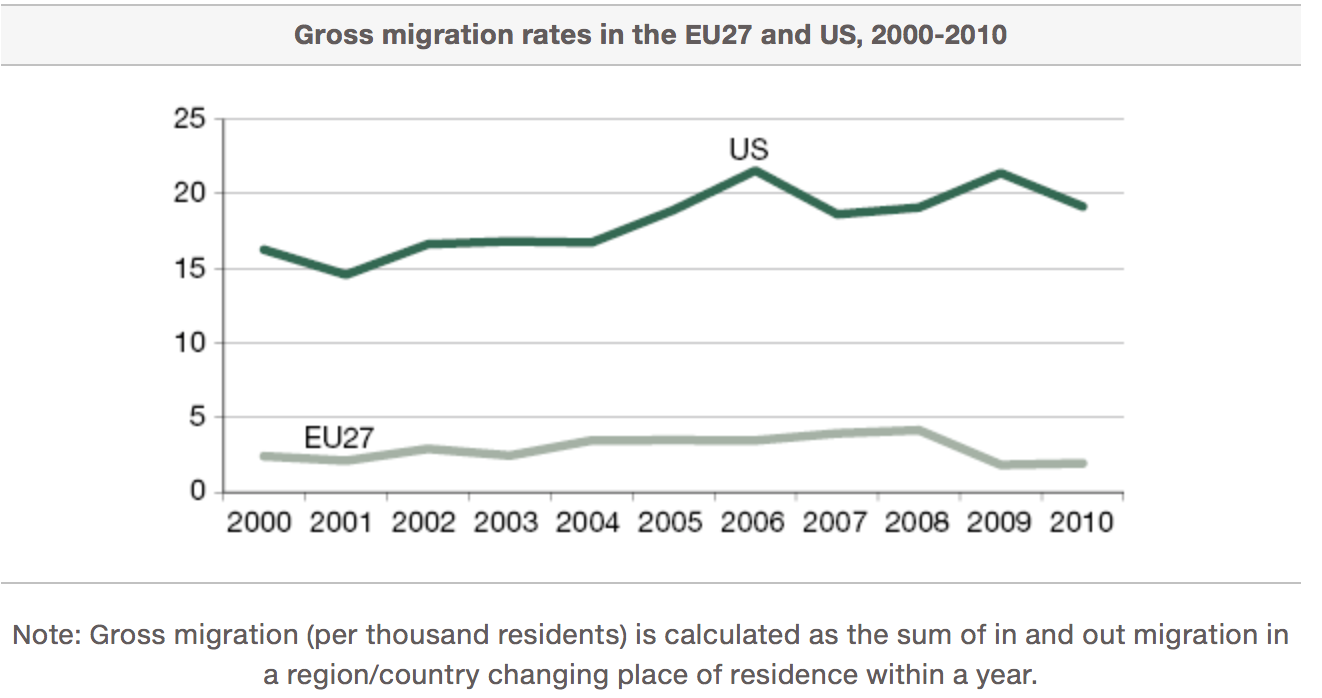
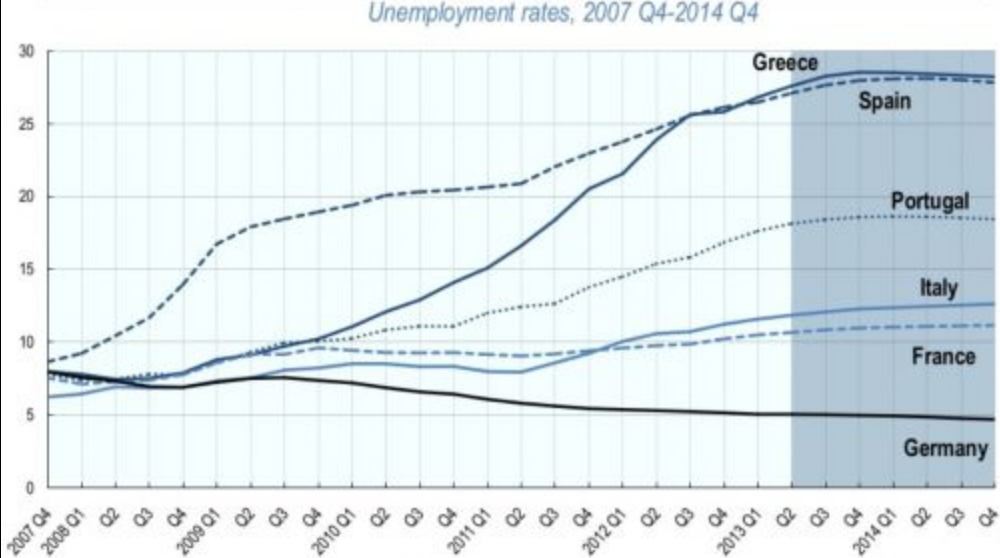
HOLLOWING OUT IN AN IMPERFECT COMMON CURRENCY UNION: AN EXAMPLE
Until exchange rate parities were fixed, the European Single Market allowed for free movement of people, goods, services, and capital, while also retaining an adjustment mechanism. If and when a country was becoming uncompetitive compared to the others, and began accumulating balance of payment deficits, it would simply devalue its currency. These moves would be a series of “one-off” affairs, if a country was systematically growing its productivity below the rates of its neighbors, as in Italy, or a true one off, like when Belgium was faced with a systemic shock due to the collapse of its ironworks industry.
These competitive devaluations largely worked, although some side effects included higher long-term nominal interest rates for the countries that used them on a repeated basis. It was a safety mechanism in an otherwise integrated market, but admittedly one that prevented the Single Market from becoming a fully integrated economic zone, as European industry clusters would not be fully concentrated or reflect long term competitive trends.
From a European standpoint, this status quo was thought to be suboptimal, and it was assumed that the gains from creating a common currency would far exceed the costs. To be fair, the introduction of the Euro initially did generate material gains for all member countries. As clusters started to specialize, largely in Germany, peripheral countries that had gotten used to the use and abuse of devaluations by their national central banks benefited from massive interest rate reductions, which provided a financial opportunity for their companies to invest and retool, and for national governments to reduce interest payments on large public debt.
Unfortunately, investments were not geared towards increasing future productivity, and the pain from the increasing specialization of industry was quickly felt in the regions that were being hollowed out. Speculative real estate booms and rising property prices did ensue, but far from improving productivity, they further eroded long term competitiveness in a peculiar form of “Dutch disease.”35 The savings from falling interest rates was largely spent on vote-buying exercises through social security spending. This of course was unsustainable, for it perpetuated the very conditions of lower productivity growth compared to the most efficient regions in the Single Market, such as the Netherlands or Germany. Alberto Martín
Part of the reason why social spending immediately increased within the peripheral states is that the trade pain was quickly felt, impacting their economic activity, industry, and employment – triggering several forms of automatic social spending, like unemployment benefits. Yet the fiscal transfers between states in the Eurozone were severely limited. The budget of the E.U. represents about 1% of GDP, and only a fraction of this budget goes to regional aid. Further, it has to be split between all states, so that underperforming regions within the best performing states would also receive support, dampening the efficacy of transfers in easing inter-state inequalities.
But it has been difficult to increase transfers within the Eurozone, because there has been no political support among the “winners” to entertain massive and sustained aid for the ‘losers’ of European unification. Ultimately, that political reality, together with false national accounting, led to the Greek financial crisis, which required a substantial one-off bailout to avoid the precedent of a state leaving the Euro.
The Greek political and economic crisis was incredibly harsh, and the limited nature of intra-EU solidarity was on full display. But Greece was a small affair. The country represents a tiny percentage of the European economy. The real problem of the transfer of industrial activity becomes clearest when looking at the Italian economy, the third largest in Europe.
The more integrated the market becomes, the more intense the phenomenon. In a single market with a currency union, where currency movements can no longer help correct sustained trade deficits, negative outcomes will be even more abrupt and dramatic. Without the ability to adjust and protect marginally less competitive industries through occasional devaluation, whole segments of Italian industry withered away. Northern Italy’s production capacity was essentially limited to small and medium-sized enterprises serving as suppliers to German firms at the top of the value chain. What was left of Southern Italy’s economic prospects fell by the wayside altogether. On an aggregate level, Italian industrial production remains, twenty years later, about 15% below its level at the time of the Euro’s introduction, while Germany’s is 40% higher.
This is not to deny that the globalized market achieves an economic outcome that, in aggregate, is superior. However, the distribution of these gains among participants can lead to some being worse off than in a “protected” environment. Silicon Valley benefits from global dominance, but the regions that failed endure endemic reconversion issues. This becomes unsustainable in markets where regional identity supersedes any global sense of belonging. Over time pockets of discontent grow until majorities in losing regions dissent from the prevailing political and economic consensus. This is exactly what happened in Italy, where the Lombard League and the 5 Star Movement gained a majority in the 2018 elections. This should not be viewed as an aberration or a mistake, but rather the logical consequence of inadequate intra-European support to compensate the losers of integration.
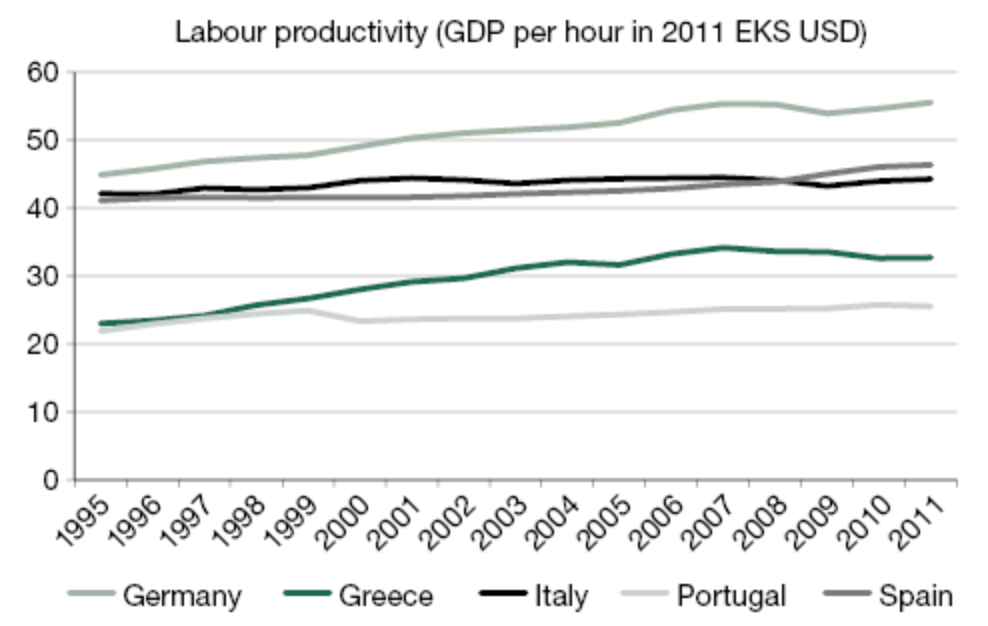
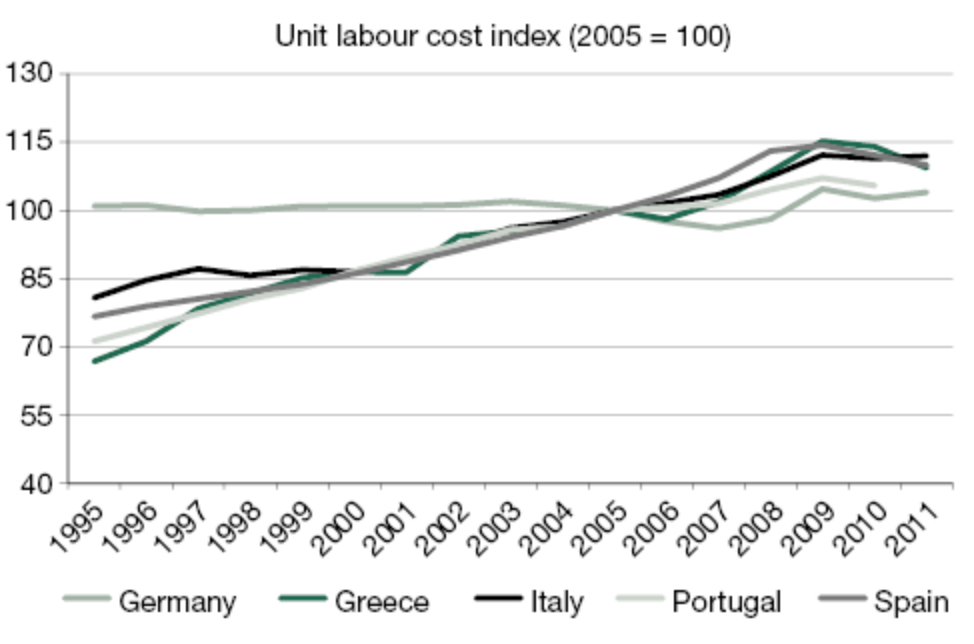
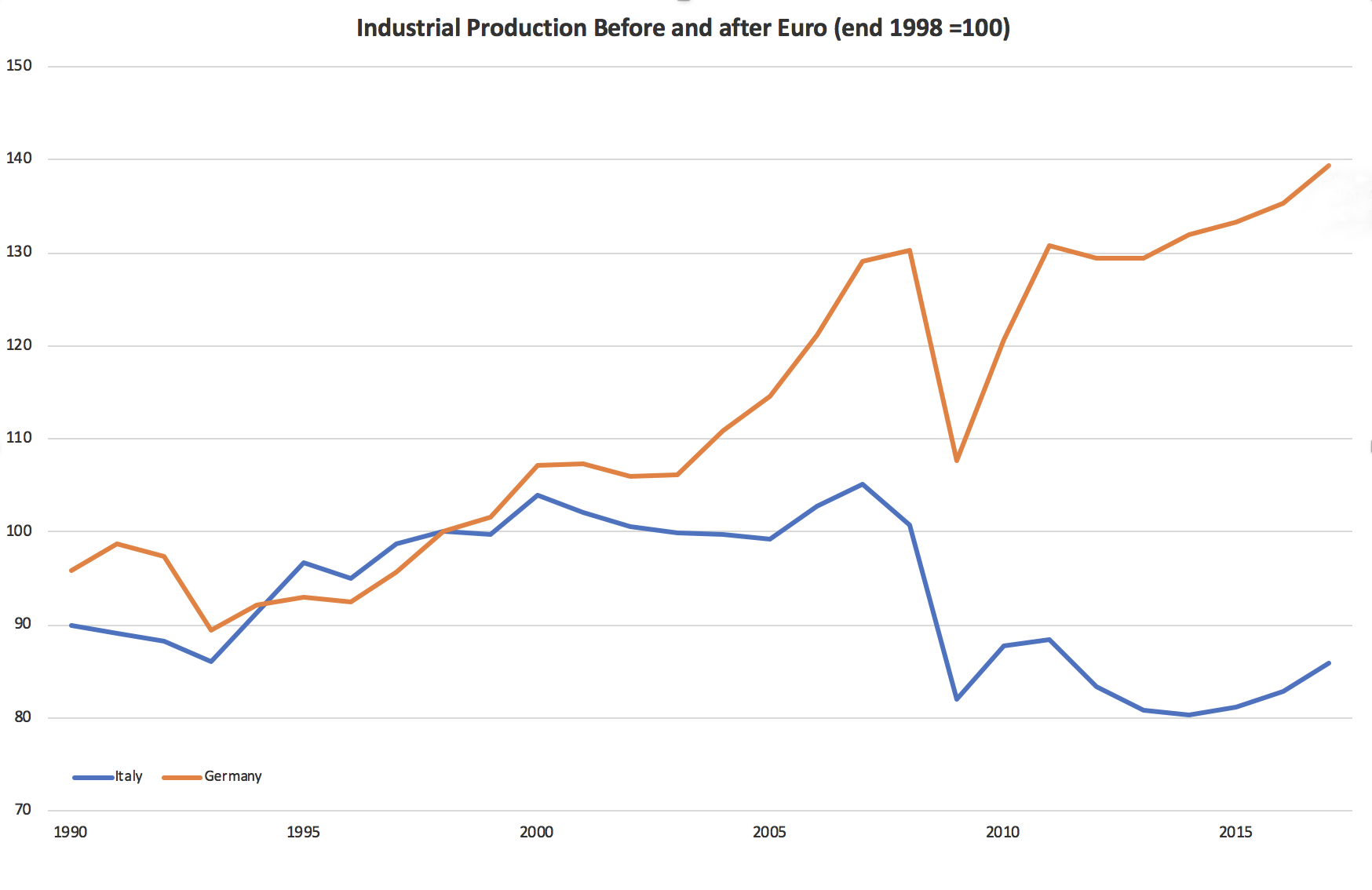
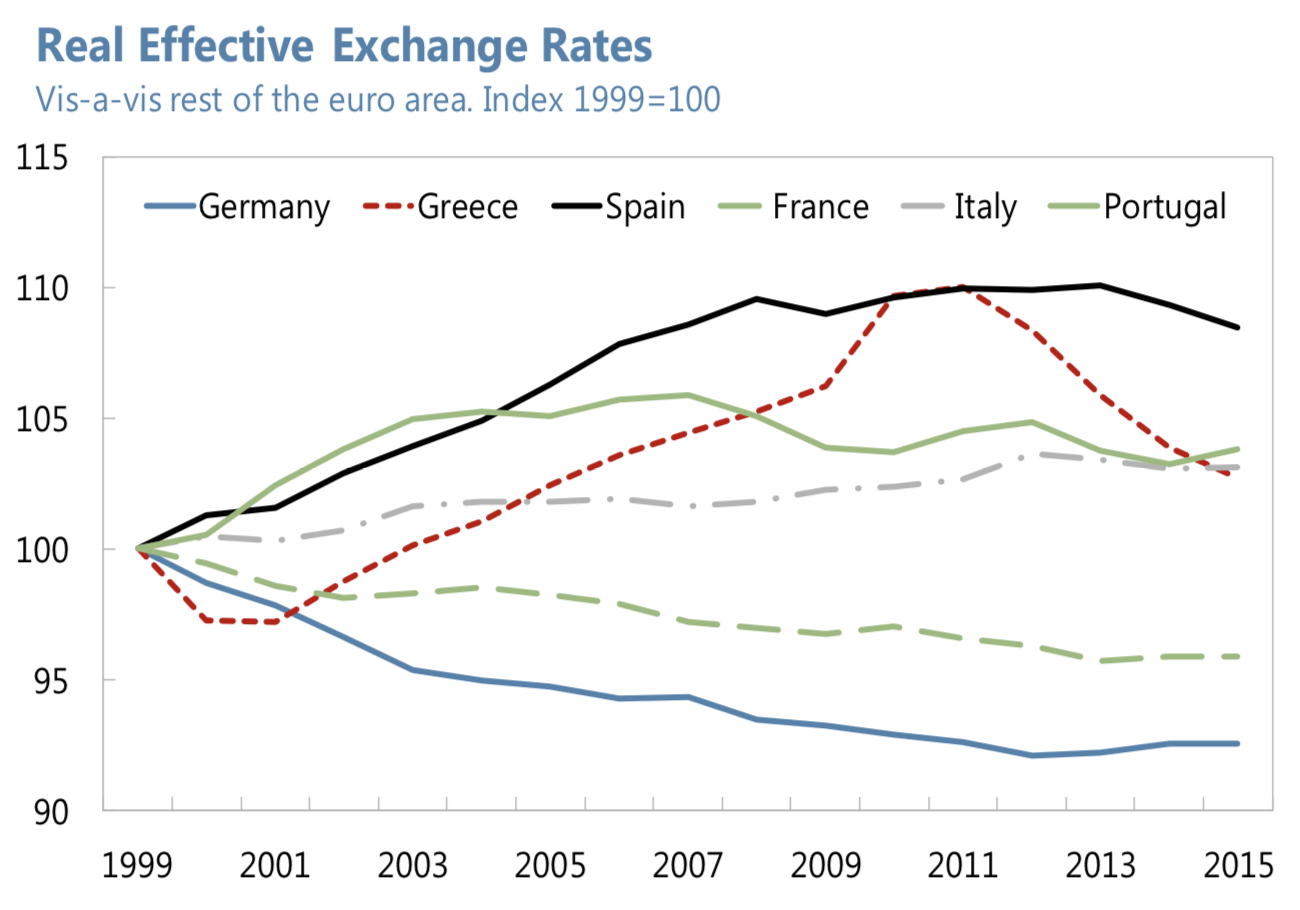
MITIGATING ASYMMETRIC LOCAL CRISIS IMPACT IN A SINGLE ECONOMIC REGION
The ability of an integrated economic region to sustain itself is dependent on its ability to address long-term structural issues as well as asymmetric shocks. The latter requires government intervention on a large scale, but the task becomes much easier if the region is financially integrated. The problem for the Eurozone, as a recent European Central Bank (ECB) report on financial integration makes clear, is that its regional “pain sharing” capacity is relatively low.
In the United States, just over a third of any asymmetric shock is absorbed by the specifically affected U.S. state; the rest of the “pain” is transmitted and shared through federal fiscal policy (15 percent), credit markets (14 percent) and capital markets (36 percent). When a given state goes into recession, the federal government automatically becomes a net contributor to the local economy via a combination of automatic stabilizers, including lower tax collection and increased expenditures. The financial sector absorbs and distributes the rest. Out-of-state creditors lose on their extended loans to the affected state’s bankrupted industries and consumers. Pension funds and insurance companies from the rest of the country lose on their equity and bond holdings from the impacted state’s corporations. Pierfederico Asdrubali36
By contrast, the ECB measurement shows that over 80 percent of a eurozone country’s shock would be retained domestically, with less than 20 percent of the economic pain shared with the rest of the euro zone. Yet such sharing is critical to the political sustainability of a common currency because the fiscal straitjacket imposed by the E.U.’s debt and deficit limits, together with the national central banks’ inability to devalue currency, means economic crises cannot be easily mitigated or addressed by traditional macroeconomic policies37.
The ECB indicators not only reveal that the level of financial integration in the euro zone is the same as it was 15 years ago but also that the concentration of credit would worsen the local impact of a crisis, possibly though a geographically localized banking crisis. Indeed, since the last financial crisis, European banking has “renationalized.” Cross-border mergers & acquisitions among financial institutions in the euro zone have been steadily declining and compare very unfavorably to the United States. Further, in Europe, the level of domestic government and corporate bonds held by financial institutions within the issuing country is now higher than at the euro’s inception. That means that much of government debt is held by same-nation banks, rather than dispersed throughout the euro zone; a crisis in, say Italy, would be most acutely felt by Italian banks and the Italian economy, and so forth38.
To compound the problem for the country impacted by the shock, high-skilled young graduates can migrate in search of opportunity, leaving a higher proportion of benefits-supported, low skilled labor behind. Countries no longer able to defend themselves through traditional economic tools are left with the liabilities while their human capital is hollowed out. This is exactly what happened in Italy, Spain, and Portugal, and to some extent in France, since the euro’s financial crisis in 2012, leaving high unemployment and a political backlash that’s still playing out.
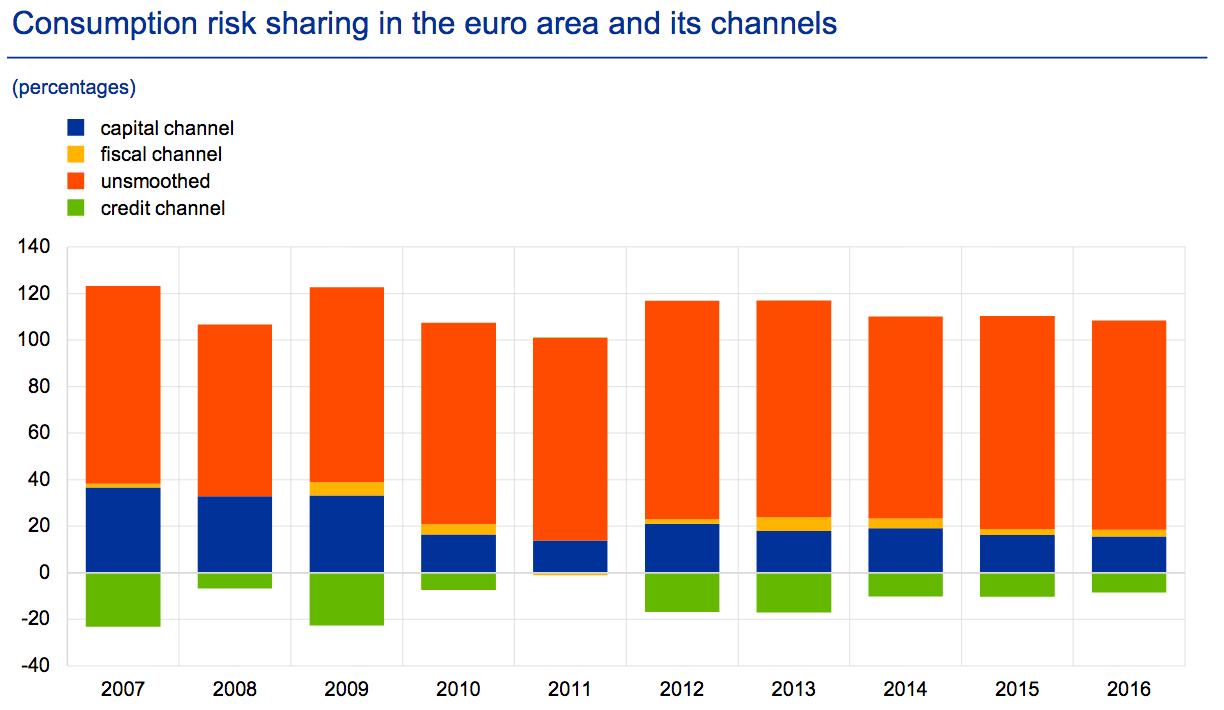
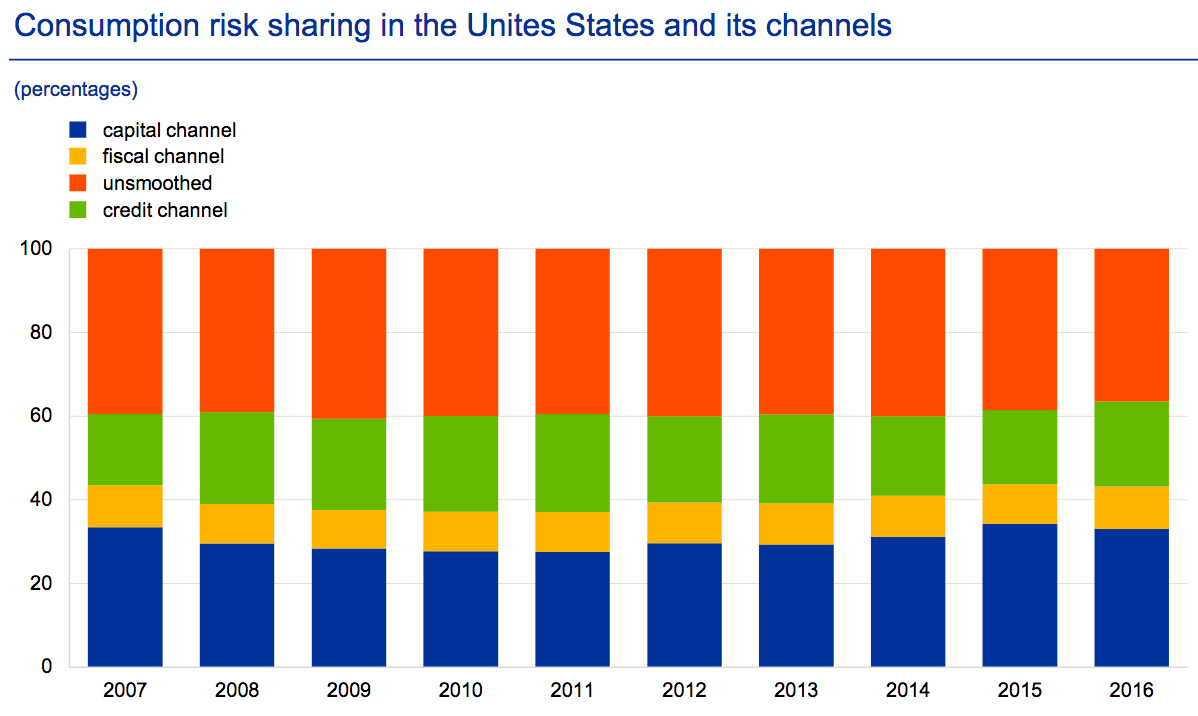
HOLLOWING OUT FUTURE ECONOMIC POTENTIAL: THE SPANISH EXAMPLE
Spain was for a long time the poster child for successful European economic convergence under the Maastricht treaty and the Euro. Before the financial crisis, it had some of the continent’s best macro-economic figures, with a debt under better control than most countries. Part of this was an illusion due to a real estate bubble financed by too-low interest rates, while part reflected real effort and indeed convergence. But all the while Spain was losing its best human capital to Europe’s growing industrial clusters, a phenomenon temporarily obscured by massive migration of lower-skilled migrants from Latin America, which resulted in a net population increase.
Young Spanish engineers have been increasingly moving to places like Germany or England. Who can blame them when starting wages offered in Bavaria are twice as high as what they can earn in Spanish industry? They are part of a new kind of emigration – that of young, educated, and skilled workers moving from Europe’s periphery to its core. The implications of this movement for the Spanish economy, and the eurozone, should not be underestimated.
My young nephew, a brilliant Spanish-trained engineer, has recently moved to the U.S. to complete a Master’s in computer science at the University of Southern California. Growing up in the deprived, if sunny, region of Andalusia, his dream was to become a professor at a Spanish university. But there was no research budget or infrastructure to take him down that path within his native country. He is now thriving in California, and may well achieve his goal of obtaining a PhD and doing research. But I doubt he will ever return to Spain to teach. How many students are raised to get an engineer? How many engineers to get a researcher? Why is it we repeatedly fail to invest and retain valuable Human Capital?
At first glance, it seems Spain should be able to hold on to its educated and skilled workers a little better these days. With the Spanish economy recovering, business confidence is back up. Economic growth is hovering around 3% this year and the current account balance shows a marginal surplus. Even Spain’s famously high unemployment rate is now well below 20%.
Unfortunately, these results have been achieved at huge economic and social cost and can only be a driver of further job creation if they are combined with much more reform. In order to absorb the shock of the banking and real estate crises, the government incurred a ballooning government debt, from 69% of GDP in 2011 to close to 100% today. At the same time, despite some labor market reforms and tax cuts, labor laws remain stubbornly restrictive. Indeed, Spain recently ranked dead last in an OECD review of barriers to entrepreneurship.
Persistently poor employment prospects, meanwhile, have pushed people out. Spain, which had positive net migration until 2010, has since seen its population decline markedly, with a negative balance to other Eurozone countries of about 40,000 people in 2013. Worse, while retirees still come to Spain, it is often the more motivated and best-educated youth who are leaving. The pattern repeats across the “Club Med” peripheral countries of the Eurozone, where the proportion of highly educated citizens emigrating from Spain, Italy, Greece and Portugal increased to 41% in 2011-2012, nearly double the level of the pre-financial crisis period.
While Europe’s economic core clusters benefit from this free influx of working-age, educated talent – human capital at its best – the Spanish economic engine, like those of the other peripherical countries, is being deprived of fuel. This is a fundamental cause of the lack of productivity growth. The best human capital is leaving. Since the 1990s, Italy and Spain have seen their productivity gains erode compared to the Eurozone “core” countries.
One could argue that the only meaningful support has been the bond acquisition program of the ECB that has limited interest rate hikes in countries perceived as riskier. Overall, however, except for ECB and government debt purchase support, net transfers to suffering and adjusting member countries have been minimal.
Peripheral countries like Spain are learning this the hard way, with little or no fiscal policy room left. As the rising popularity of anti-establishment parties show, this may no longer be socially and politically sustainable, with populist and separatist parties gradually gaining ground.
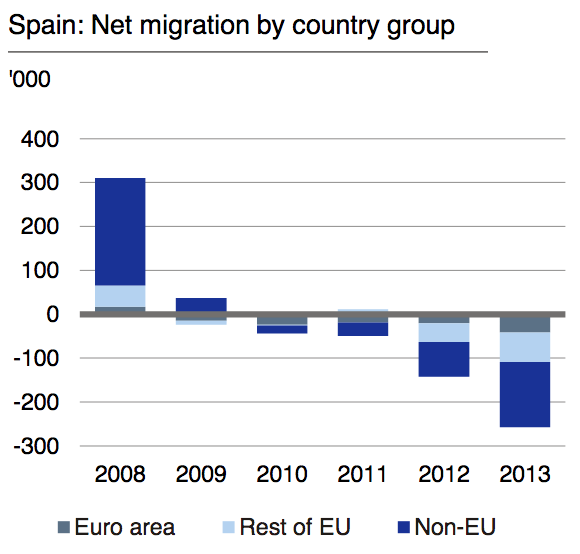
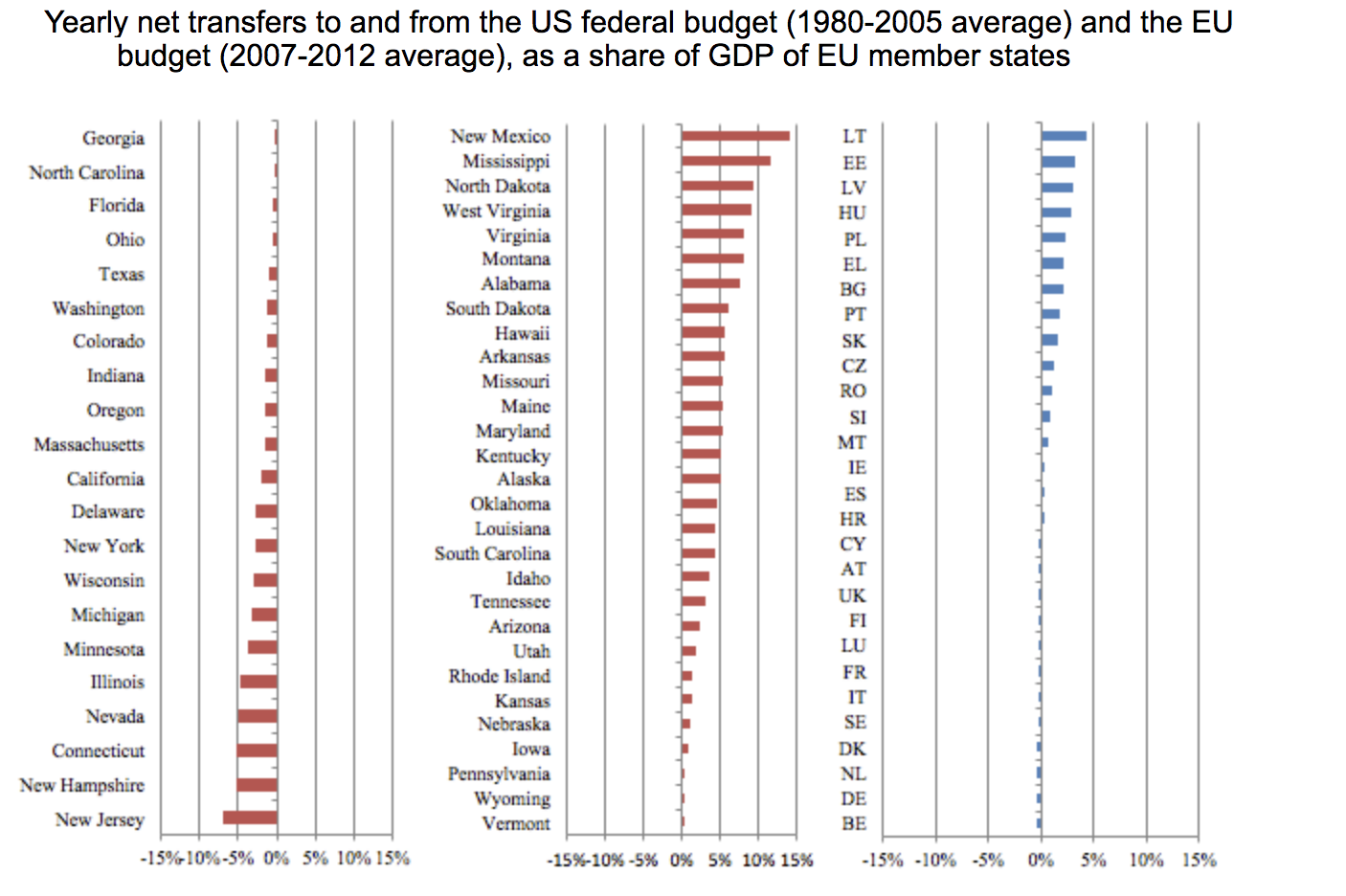
HOW MUCH DO POLITICALLY UNITED REGIONS PAY IN REGIONAL POLICY?
It is enlightening to compare Germany’s attitude to its Eurozone partners to its handling of East German reunification. When it was incorporated in the Federal Republic, East Germany was in dire straits and simply could not compete with the currency exchange that was imposed. This led to the hollowing out of large parts of its economy, with massive migration to what had been West Germany.
The German government however undertook a massive investment and restructuring program. It rebuilt infrastructure and implemented development programs. As this did not prevent the immediate hollowing out, large transfers were put in place and maintained for more than 20 years to ensure that a reasonably comparable level of living was achieved even in the most unproductive places. Despite massive annual transfers of close to 5% of West Germany’s GDP, it took 25 years for migration from the East to the West to finally stop. Over the last 25 years, the total volume of transfers has reached close to an eye watering $2 trillion. This was financed by interregional transfers as well as a “solidarity tax” of 5.5% on income ECFin CSMonitor.
This was not always the case. As a teenager in the ’80s, I remember visiting Spain and driving along the first true highways ever built along the country’s southern coast. These highways, as advertised by big boards along the construction sites, were made possible by a cohesion transfer fund established by the E.U. for new members. In effect, the E.U. was paying for a large percentage of the infrastructure investment needed to facilitate new economic activities while markets were being opened and integrated. But the budget for this fund did not grow with the Euro introduction. In fact it was diverted to needier Eastern European countries as the E.U. expanded. Regional Support to southern countries – and subsidized infrastructure investment – was reduced precisely when the Euro came into being. No new funds were raised for direct transfers to accompany the imposition of a single currency and the removal of devaluation as an adjustment mechanism. Infrastructure constructions were replaced by massive home building in a low interest rate fuelled bubble.
These massive wealth transfer programs were only possible because national identity trumped regional identity within Germany, making such sacrifices politically palatable. Had they not been in place, it is entirely possible that East German local political opposition would have emerged against the integration and its concomitant hollowing out. Indeed, even with these transfers, it is noticeable that Germany’s “extreme” or populist parties fare better in the former East Germany.
To put things into perspective, the European Union’s budget stands at about 1% of GDP. Out of this, about a third is spent on regional policy, which has to be distributed across all countries, including the wealthiest member states. Various studies have indeed put the level of transfer from “net beneficiaries” to “net contributor” in the EU at about 0.25% of GDP. In other words, the German budget “cohesion” transfers were 20 times higher than today’s intra-European transfers as a percentage of GDP. Or to put things in another light, intra-European transfers are half the size of the EU member states’ cumulative spending on overseas development assistance (about 0.5% GDP).39
Another comparison can be given with the U.S., a well-established ongoing fiscal and monetary union. While the level of federal support will vary tremendously by state, reaching up to 10% of a recipient state’s GDP (Mississippi, New Mexico), it is on average about 1.5% of GDP. This is again about 6 times what the E.U. currently spends on intra-union transfers. During crisis years, as in 2009-2010, this amount can increase by a multiple in the U.S. as its federal budget can run a deficit, while the E.U. cannot.
Whichever way you look at it, the European Union, and in particular the Euro zone, is built on the cheap, with annual cohesion transfers well below any comparable international situation. The inability, because of the lack of political cohesion, for the Euro winners to transfer part of their gains to the “losers” translates into extreme socio-economic pain in the countries that have given up their ability to pursue competitive devaluation. This in turn leads to localized populist movements of various strains, from a populist coalition taking power in Italy to local separatism, as in Flanders, Lombardy, or more forcefully in Catalonia, where the latest round of major secessionist unrest came in 2018.
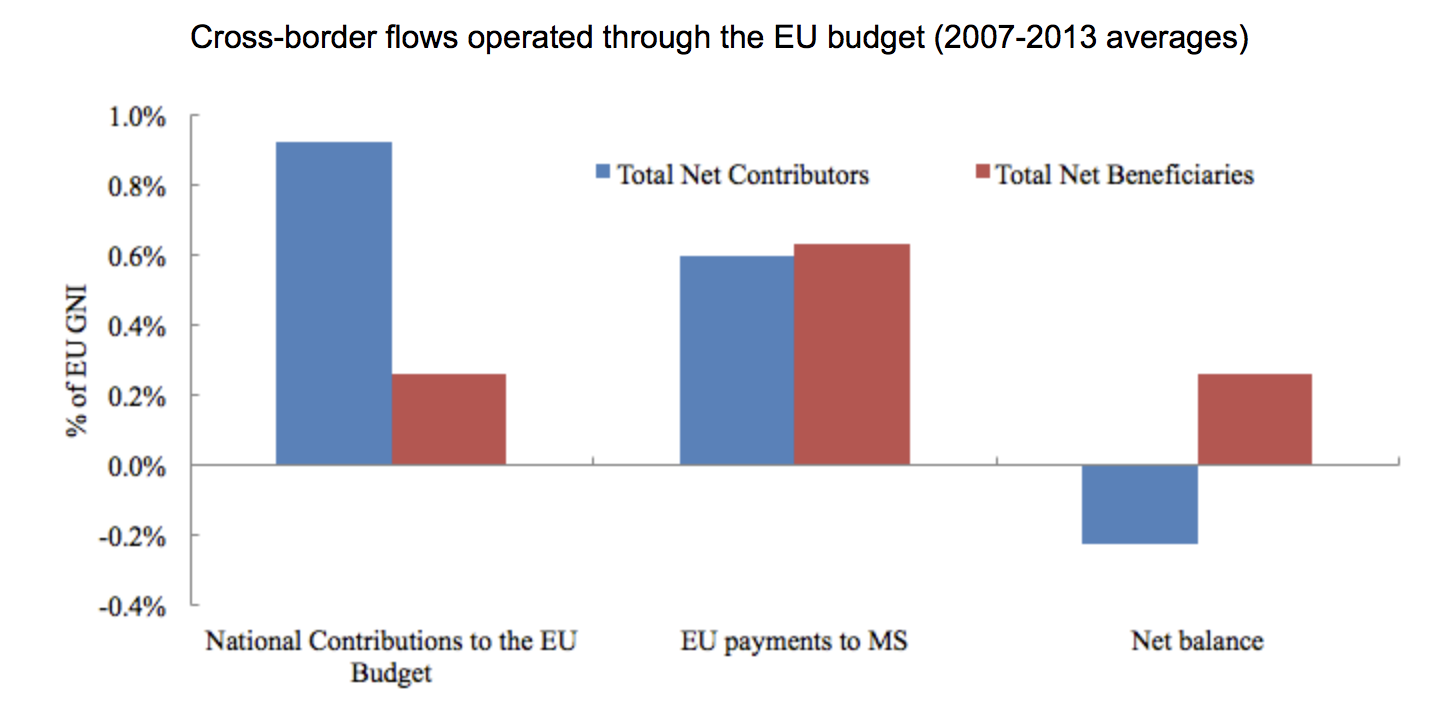
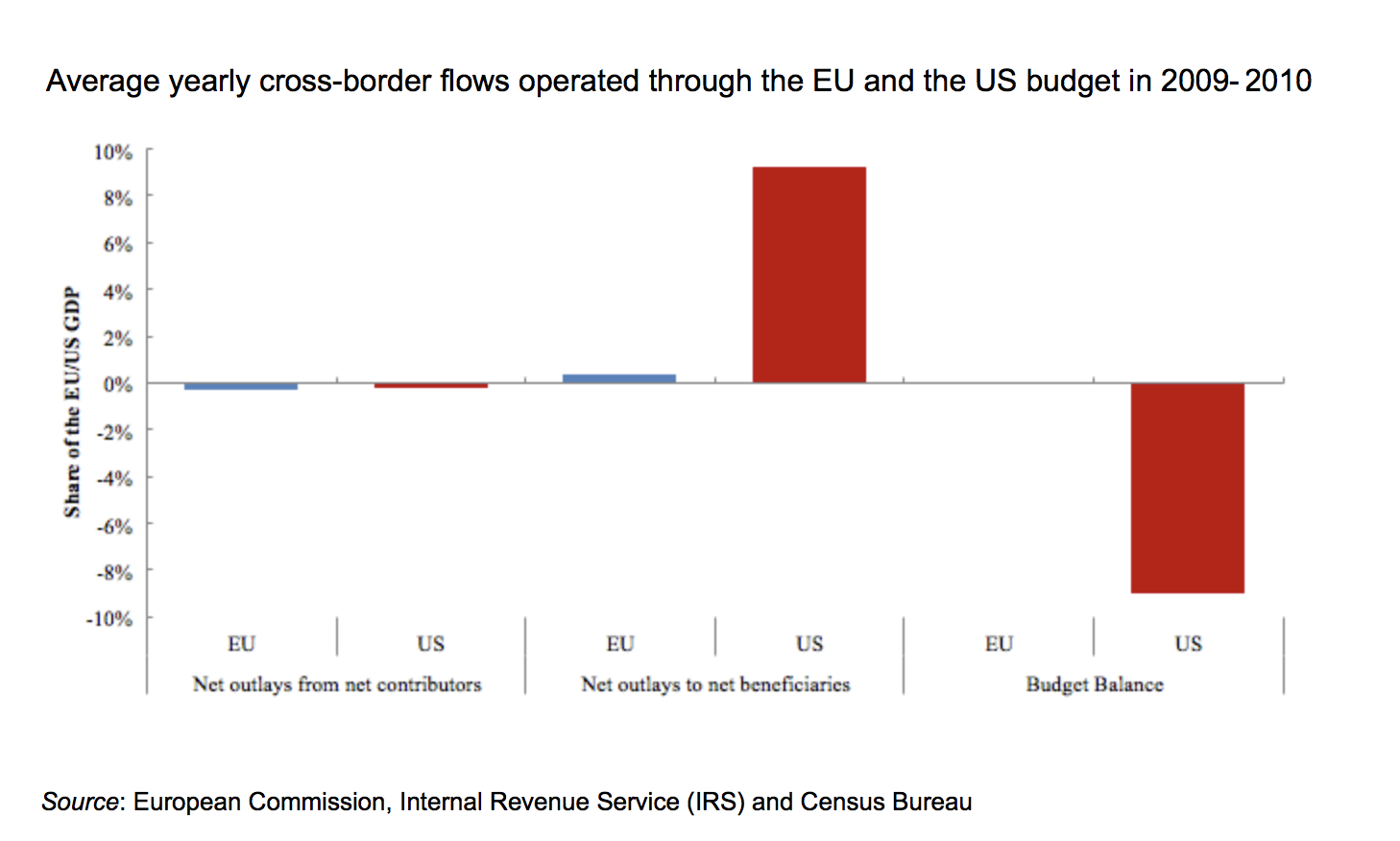
FROM WIN-WIN TO LOSE-LOSE?
By failing to confront these issues at the outset with a regional policy featuring proper transfer mechanisms, the conditions were created for a “blow up” of the hollowed states. The economic conditions in these states will deteriorate inexorably. It is easy to see that the political classes in the hollowed states, benefiting from lower interest rates, will be tempted to buy short-term peace with social benefits spending financed via massive borrowing, allowing them to continue profiting privately until states go bankrupt, forcing some sort of dramatic action.
This means that the hollowed states will, predictably, generate a sovereign state crisis after years of inaction, and that nonperforming loans will necessarily accumulate in the local banking sector.
The answer from a central banking authority in these circumstances, will be, as we have seen, to buy time by lowering interest rates. But this will be an arbitrage between the indebted hollowed-out country and the “savers nations.” The savers nations are of course the ones that benefited from the economic concentration to start with.
Ultimately, the savers will lose part of the capital gain they were expecting, for the economic situation has truly taken a downturn in the hollowed-out states. This will either take the form of a “blow up,” such as in Greece, or a drastic reduction in the interest rates paid to the savers.
The ECB’s dovish monetary policy in recent years can be better understood in this context: the 2015 QE extension was a clear reaction to a sovereign spread crisis.40 The negative interest policy of course touched a popular nerve through its increasing impact on German household savings, creating widespread resentments that are starting to have political ramifications. It is important to remember that the rise of the German far-right AfD party started not with immigration (which added fuel to the fire), but with some German savers’ increasing unease about the Euro, and in particular the negative interest rate which acts as a stealth tax on savings. Faced with the AfD’s rise, other mainstream German parties have been forced to react. Components of the Christian Democratic Union and the Christian Social Union have now also openly challenged the ECB.
German critics of ECB policies are not new. To start, German economists, politicians and business leaders had expressed concerns that the ECB’s set of unconventional measures41 were subsidizing the wrong policies in the European periphery, preventing necessary reforms. As the ECB intensified QE, concerns were raised that this was effectively monetary financing, a breach of the EU’s founding treaty. Then increasingly low interest rates were criticized as generating bubbles, weakening the profitability of the commercial banks and allowing a Japanese style “zombification”42 of the private sector.
The ECB, led by Mr. Draghi, ignored German criticism and concentrated on preventing the sovereign spread crisis from turning into a Greek-style scenario on a massive scale. The German member of the ECB board has, reportedly, been systematically put into a minority with a few other countries – a dangerous precedent given the importance of the German economy in Europe. The ECB in fact rejects “en bloc” all the German arguments, and has even produced a policy paper rebuttal in which it claims that:
The “argument that central banks’ low nominal interest rate policies expropriate the saver is flawed … if low interest rates are a conscious and appropriate reflection of weak inflation and growth dynamics, there is no reason to believe that they are particular contributors to possible bubbles … the current low inflation/low real growth/low interest rate environment does not make the life of highly indebted governments particularly easy.” And “depositors may, in fact, be amongst the winners from low interest rate policies.”
It’s a strained argument, to say the least. But the ECB is in a difficult position. The burdens placed on it by the structural flaws of the EU are unfair. Faced with government inaction and an incomplete monetary union, it has done what it can with imagination and gusto. But even when its policies failed by its own measures, it has been doubling down, ignoring the increasing risks of increasingly ineffective policies. In the process, it has ignored or rebuked its largest shareholder and supporter, to the point that it is now effectively supporting the emergence of a large anti-European party in Germany for the first time since World War II.
The key to understanding the shift in popular mood against the ECB in Germany may lie in an analysis of household savings and the logical effect of lower rates. As a percentage of disposable income, German savings are materially lower than the Eurozone median. But it has among the lowest liabilities and has been steadily deleveraging, which implies that it benefits relatively from high interest rates. Further, real estate – whose price is being propped up by low interest rates – makes up a relatively small portion of German household assets, which are instead disproportionately held in bank deposits that no longer yield anything.
The obvious negative impact on German savers has been noted repeatedly by private sector leaders. The chairman of the board of Allianz, the Munich-based financial giant, recently complained that the “ECB is devaluing savers’ money.” The head of Munich RE, after criticizing the ECB for creating asset bubbles that redistributed to the wealthiest, warned, “The people of Germany aren’t stupid.”
In this context, the Alternative for Germany (AfD), a right-wing populist party that had opposed the German government’s generous refugee policy, started winning elections to the detriment of the mainstream CDU/CSU. It is now widely believed that AfD is shifting its focus to the negative effects of ECB policies on German savers, potentially threatening the leadership of traditional parties. This has forced the parties backing the German Chancellor to respond. “The German government must demand a change in direction on monetary policy. If things continue as they have, it will be a boon for the AfD,” the finance minister of Bavaria rightly predicted, asking for “a debate in Germany about the erroneous policies of the ECB.”
It is no small feat for the ECB to have created vocal political opposition in the country that stood against all for the independence of the central bank. To keep on ignoring it could create the political conditions for the end of the Euro, and with it, possibly, of the European project as we know it. No wonder that the German financial minister said the ECB measures could “ultimately end in disaster.”
When even the German elites, the E.U.’s Single Market biggest winners, are sounding the alarms, you know it is time for a rethink.